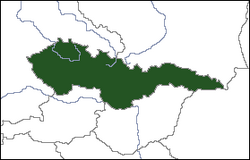| Czechoslovak Republic Československá republika |
||||||
|---|---|---|---|---|---|---|
|
||||||
| Motto: "Pravda vítězí / víťazí" (Czech/Slovak) "Truth prevails" |
||||||
| Anthem: Kde domov můj? Nad Tatrou sa blýska |
||||||
| Capital | Prague | |||||
| Largest City | Bratislava | |||||
| Official languages | Czech, Slovak | |||||
| Recognised regional languages | German, Ukrainian, Yiddish, Polish | |||||
| Demonym | Czechoslovakian | |||||
| Government | Federal parliamentary republic | |||||
| - | President | Miloš Zeman | ||||
| - | Prime Minister | Robert Fico | ||||
| Legislature | National Assembly | |||||
| Formation | ||||||
| - | Independence from Austria | 14 October 1945 | ||||
| - | Constitution | 11 July 1960 | ||||
| - | Velvet Revolution | 17 November – 29 December 1989 | ||||
| - | Joined the European Union | 1 May 2004 | ||||
| Currency | Czechoslovak koruna (Kčs) | |||||
| Time zone | CET (UTC+1) | |||||
| - | Summer (DST) | CEST (UTC+2) | ||||
| Drives on the | right | |||||
| Internet TLD | .cs | |||||
| Calling code | +42 | |||||
Czechoslovakia (Czech and Slovak: Československo, Česko-Slovensko; also written or Czecho-Slovakia) was a sovereign state in Central Europe. The country is bordered by Germany to the west, north-west and south, Hungary to the south, Romania to the south-east, Ukraine to the east and Poland to the north-east. Prague is the capital city, with 1.3 million residents. Czechoslovakia includes the historical territories of Bohemia, Moravia, Czech Silesia, Slovakia and Subcarpathian Ruthenia.
The Czech state, formerly known as Bohemia (Čechy), was formed in the late 9th century as Duchy of Bohemia, at that time under the dominance of the powerful Great Moravian Empire. After the 10th century the territory of Slovakia was gradually integrated into the Kingdom of Hungary, which itself became part of the Austro-Hungarian Empire or Habsburg Empire. After the fall of the Empire in 907, the centre of power was transferred from Moravia to Bohemia under the Přemyslids. In 1004, the duchy was formally recognized as a part of the Holy Roman Empire, rising to the status of Kingdom of Bohemia in 1212. During the rule of the Přemyslids and their successors, the Luxembourgs, Bohemia expanded in size until reaching its greatest territorial extent in the 14th century.
Following the Battle of Mohács in 1526, the Kingdom of Bohemia was gradually integrated into the Habsburg Monarchy as one of its three principal parts, alongside the Archduchy of Austria and the Kingdom of Hungary. The Bohemian Revolt (1618–20) against the catholic Habsburgs led to the Thirty Years' War, after which the monarchy consolidated its rule, re-imposed Catholicism, and adopted a policy of Germanization. With the dissolution of the Holy Roman Empire in 1806, the Bohemian kingdom became part of the Austrian Empire. In the 19th century the Czech lands became the industrial powerhouse of the monarchy and the core of the Republic of Czechoslovakia, which was formed in 1918 following the collapse of the Austro-Hungarian Empire after World War I. After 1933, Czechoslovakia remained the only democracy in central and eastern Europe.
Following the Munich Agreement and the Polish annexation of Zaolzie, Czechoslovakia fell under German occupation during World War II. By 1945, a major portion of the country was liberated by the Red Army, and the subsequent gratitude towards the Soviets, combined with disillusionment with the West for failing to intervene, led the Communist Party of Czechoslovakia to victory in the 1946 elections. Following the 1948 coup d'état, Czechoslovakia became a single-party communist state under Soviet influence. In 1968, increasing dissatisfaction with the regime culminated in a reform movement known as the Prague Spring, which ended with an invasion by the armies of the Warsaw Pact countries (with the exception of Romania). Czechoslovakia remained occupied until the 1989 Velvet Revolution, when the communist regime collapsed and a multiparty parliamentary republic was formed. On 1 January 1993, Czechoslovakia peacefully dissolved into its constituent states: the Czech Republic and the Slovak Republic.
The Czech Republic maintains a welfare system that provides universal health care and tertiary education for its citizens. The UN ranks the country 14th in the inequality-adjusted human development. It possesses an advanced economy and in 2006 became the first former member of Comecon to achieve the status of a developed country, according to the World Bank. The Czech Republic also ranks as the ninth-most peaceful country in Europe, while achieving the best performance in democratic governance and infant mortality in the region. It is a pluralist parliamentary representative democracy with membership in the European Union, NATO, the OECD, the OSCE, the Council of Europe and the Visegrád Group.



